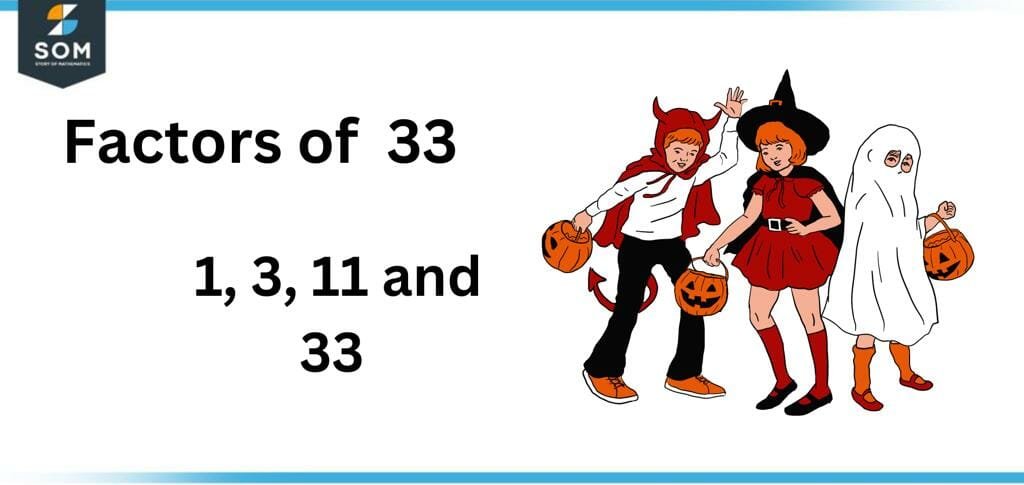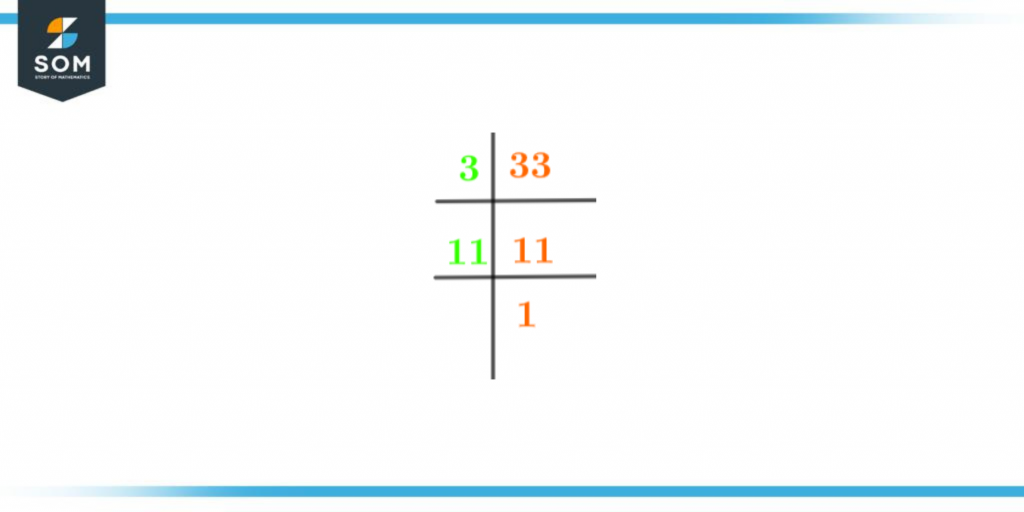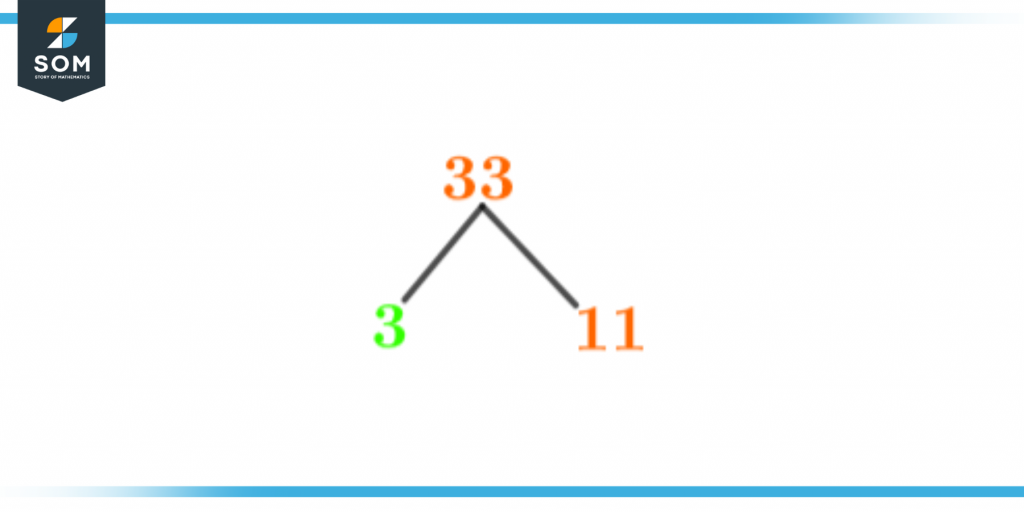JUMP TO TOPIC
Factors of 33: Prime Factorization, Methods, Tree, and Examples
Factors of 33 refer to the numbers by which 33 can completely be divided, or they are those numbers whose product is 33 when two numbers are multiplied together. Therefore, if a number divides 33 with 0 as the remainder, it is considered a factor.
Figure 1 – All possible Factors of 33
What Are the Factors of 33?
The factors of 33 are 1, 3, 11, and 33. It has more than two factors, so it is a composite number. In total, the number 33 has four factors. The factor pairs are (1, 33) and (3, 11). To do this, pair the integers together so that the outcome is 33. The result is always zero whenever 33 is divided by these numbers.How To Calculate the Factors of 33?
To calculate the factors of 33, Division and Multiplication are the two techniques that can be used. Let’s begin by discussing how to apply division to determine the factors.Division
First, identify all the numbers that are less than 33. Second, multiply each value by 33. Its factors are divisions of 33 that result in a remainder of 0. Let’s look at the example below to get a better idea: Thirty-three can be divided by 3, the smallest factor of 33 besides 1, to get 11. Therefore, 3 and 11 are the factors of 33. \[ \frac{33}{3} = 11 \]This proves that the quotient and divisor (3 and 11) are both factors of 33 because the quotient is a full integer and has no remainder. The following are the factors of 33:\[ \frac{33}{1} = 33 \]\[ \frac{33}{3} = 11 \]Hence, the division process considers factors 33 are 1, 3, 11, and 33.Multiplication
To get the factors of 33, let’s now concentrate on multiplying. Consider 33, the sum of two whole numbers in all possible situations. Every single integer is a factor of 33 in each of these products. Take a look at the examples below:1 x 33 = 33
3 x 11 = 33
11 x 3 = 33
33 x 1 = 33
Thus, these are the factors of the number 33.Factors of 33 by Prime Factorization
Prime factorization is the technique of determining the prime factors of a given number by splitting it into its factors via the division or upside-down division method. It is the most straightforward technique that divides a number equally and is used for finding its factors.Prime factorization is the technique for determining or representing a given integer as the product of prime numbers. Below is the procedure to find the factors of 33 through prime factorization:Below is the process to find the factors of 33 through prime factorization:Firstly, products 3 and 11 can be used to factor 33.3 x 11 = 33
Secondly, examine the factors to determine whether each is important. \[ \frac{33}{2} = 16.5 \]\[ \frac{33}{4} = 8.25 \]\[ \frac{33}{5} = 6.6 \]\[ \frac{33}{7} = 4.71 \]These are not the factors of 33, as the answer is not a whole number. Instead, it is a decimal number. As a product of 3 and 1, the prime number 3 can be separated from other primes. As a result, the product of 11 and 1, which is a prime number, 11, can be divided as both numbers meet the factorization conditions and can be multiplied as-is because they are prime numbers. Hence, the prime factors of 33 are 3 and 11. To denote the prime factors of 33, the notation 3 x 11 is used. The diagram of Prime Factorization of 33 can be seen below:
Figure 2 – Prime Factorization of 33
Factor Tree of 33
Factor trees are one of the many ways to graphically depict a number’s prime factors, while a number’s factors can be expressed in various ways. The root of the factor tree is an actual number, and the branches that sprout from it go up to the prime number. Therefore, it represents factors. Due to this, 3 and 11 are regarded by prime factorization as being the prime factors of 33.The Factor Tree of the number is shown below:
Figure 3 – Factor Tree of 33
- The biggest positive number not divisible by a sum of triangular numbers is 33. Also, the first two-digit dodecahedral number with a center is 33.
- The first four positive factorials are added to form the number 33. Moreover, the first six positive integers’ sum of divisors equals 33.
- It is 33, the lowest odd repdigit that is not a prime number.
- Since 2015, the NFL’s extra point distance has been 33 yards, and the World Snooker Championship semifinal matches last 33 frames.
- The Los Angeles Laker’s 33-game winning run, which they accomplished during the 1971-1972 NBA Season, is the longest winning streak in the history of the NBA.
- 33 letters make up the contemporary Russian alphabet. Similarly, at the moment, Georgian is written using a 33- letter alphabet.
- 33 is the arsenic atom’s atomic number. Furthermore, based on the Newton scale, the boiling point of water is 33 degrees.
- A typical human spine contains 33 vertebrae on average.
- The Indianapolis 500 has historically included 33 racers, according to the world of motorsport.
- Dark, a science fiction television program from Germany that follows interconnected plotlines spanning 33 years, refers to the number 33.
Factors of 33 in Pairs
A Factor pair is a set of two integers; when multiplied, they yield the number itself as the outcome. The following is the list of the positive factor pairs of 33: If 1 × 33 = 33, then (1, 33) is a pair factor of 33. Let’s look at all the pairs: 1 x 33 = 33, (1, 33) is a pair factor of 33. 3 x 11 = 33, (3, 11) is a pair factor of 33. 11 x 3 = 33, (11, 3) is a pair factor of 33. 33 x 1 = 33, (33, 1) is a pair factor of 33. Stated above is a list of the positive factor pairs of 33. Switching the signs makes it possible to recognize the negative factor pair. The negative pair factors of 33 are given below: -1 x -33 = 33, (-1, -33) is a pair factor of 33. -3 x -11 = 33, (-3, -11) is a pair factor of 33. -11 x -3 = 33, (-11, -3) is a pair factor of 33. -33 x -1 = 33, (-33, -1) is a pair factor of 33.Factors of 33 Solved Examples
Example 1
Help Mary find the common factors between 33 and 44.Solution
Factors of 33: 1, 3, 11 and 33 Factors of 44: 1, 2, 4, 11, 22, and 44. Hence, the common factors between 33 and 44 are 1 and 11.Example 2
What is the sum of the factors of 33?Solution
The factors of 33 are 1, 3, 11, and 33.1 + 3 + 11 + 33 = 48
Thus, the answer is 48.Example 3
Jennie owns a cake shop. The cake shop is famous for its stunning variety of buttercream cakes. 11 different consumers ordered thirty-three buttercream chocolate vanilla cakes. If everyone ordered the same number of cakes, how many cakes did each person want?Solution
To fulfill the 11 customers’ orders, Jennie must bake 33 cakes. Each person places a certain number of orders, \[ \frac{33}{11} = 3 \]Therefore, the number of buttercream chocolate vanilla cakes ordered by each consumer was 3.Example 4
Find the difference between all the factors of 33.Solution
The four factors of 33 are 1, 3, 11, and 33.33 – 11 – 3 – 1 = 18
Hence, the answer is 18.All the images/diagrams are created using GeoGebra.